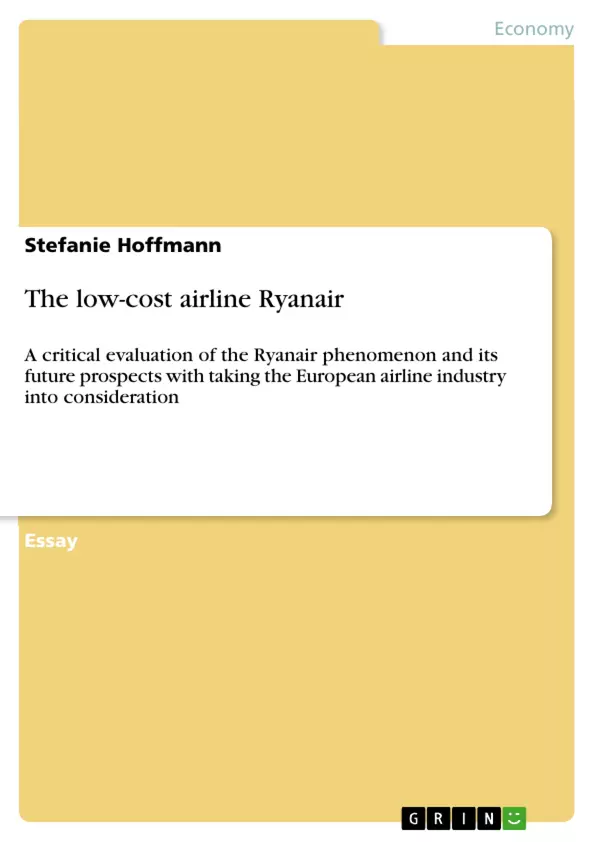Just a few years ago Ryanair was a tiny, impoverished Irish airline trying unsuccessfully to compete with Aer Lingus using a handful of elderly turboprop planes. In 2003 its share price is so high the company is worth more than British Airways, and with the unlikely business model of selling seats for as little as 99 Pence for the privilege of flying to airports perhaps fifty miles outside the cities they purport to serve, Ryanair has become the most profitable airline in Europe. It is also an airline whose phenomenal success has never been too far from controversy, whether it is its militant lack of sympathy for its passengers when their flight is delayed or cancelled, its robust approach to industrial relations, or indeed the industrial language favoured by its charismatic and buccaneering chief executive, Michael O′Leary. (Creaton, 2005) The following questions will critically evaluate the Ryanair phenomenon and its future prospects with taking the European airline industry into consideration.
Table of Contents
- Analyse the European airline industry, with implications for the budget sector, and especially Ryanair.
- The European airline industry with implications for the budget sector
- Low-Cost Market Share 2003
- Evaluate Ryanair's strengths and weaknesses.
Objectives and Key Themes
This case study examines the rise of Ryanair, a low-cost airline, within the context of the European airline industry. It aims to analyze the competitive landscape and the impact of liberalization on the industry, specifically focusing on the low-cost segment. The study critically evaluates Ryanair's success, its strengths and weaknesses, and its sustainability in the long term.
- The impact of airline industry liberalization in Europe
- The rise of low-cost carriers like Ryanair and EasyJet
- The competitive landscape within the European airline industry
- Ryanair's business model and its strengths and weaknesses
- The sustainability of Ryanair's strategy
Chapter Summaries
Analyse the European airline industry, with implications for the budget sector, and especially Ryanair.
The European airline industry has faced significant challenges in recent years, including the impact of the 9/11 attacks, the SARS outbreak, and rising fuel prices. These events have led to increased competition, price wars, and consolidation within the industry. The emergence of low-cost carriers like Ryanair and EasyJet has further disrupted the market, challenging traditional airlines on short-haul routes. The liberalisation of air transport in Europe has contributed to this competitive environment, allowing airlines to fly freely within the EU. The low-cost segment has grown significantly, with Ryanair leading the market in terms of market share.Evaluate Ryanair's strengths and weaknesses.
Ryanair's success can be attributed to its focus on cost-efficiency and its ability to operate in a highly competitive market. The airline utilizes a no-frills business model, offering low fares in exchange for limited services. However, Ryanair also faces certain weaknesses, including potential reputational risks due to its aggressive approach to customer service and labor relations. The study examines these strengths and weaknesses in detail, considering the internal and external factors that influence Ryanair's competitive advantage.
Keywords
The key themes of this case study include the European airline industry, liberalization, low-cost carriers, Ryanair, business model, competitive advantage, cost-efficiency, strengths, weaknesses, and sustainability.
- Arbeit zitieren
- Stefanie Hoffmann (Autor:in), 2006, The low-cost airline Ryanair, München, GRIN Verlag, https://www.grin.com/document/55111



